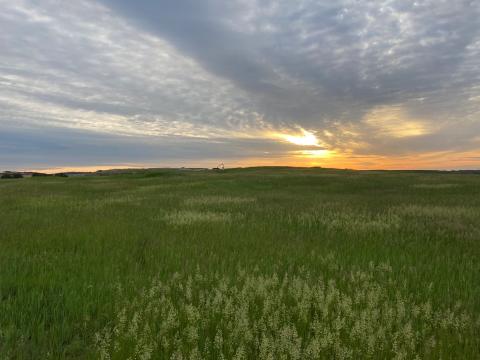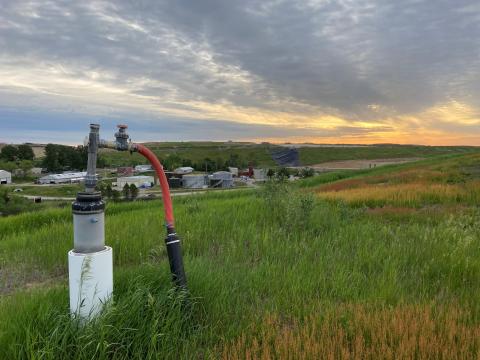Refuse or Refuge: Unexpected Findings from a Landfill

It might come as a surprise that landfills can provide a diversity of habitats capable of supporting species of conservation concern. It certainly surprised me, but if you dig into the research there is evidence that landfills, particularly capped landfills and associated manmade retention ponds and wetlands, are linked with populations of declining grassland birds and migratory waterfowl.1 Researchers have identified a need to further understand the bird communities using these areas. I was unaware of this in the spring of 2021 when Matt Tarr, UNH Extension State Wildlife Specialist, invited me to join him for a grassland bird survey at the Turnkey Landfill in Rochester. I was cautiously intrigued, but I have worked with Matt long enough to know that an invitation to tag along is always worth it. Even if it means showing up at a landfill at 5:30 am on a chilly late-May morning. Upon our arrival, we drove into a gated portion of Isinglas Drive and parked in front of a tidy row of empty dumpsters. And there rising up before us was a carefully engineered 60-acre manmade landform, a grassy hilltop on a substrate of garbage in NH largest landfill. The sun was just peaking over the horizon as we made our ascent up a long gravel road to the top. It was oddly beautiful in the morning light, and we marveled at the unexpected intersection of this buried byproduct of modern society and the potential habitat for uncommon bird species.

Over the course of our survey that morning we observed four grassland bird species within the 60-acre grassland created by this capped landfill. Grasshopper sparrows and savannah sparrows appeared to be breeding on site. Meadowlarks and bobolinks were also present but did not appear to be using the field for breeding. While most grassland bird populations in NH are declining, grasshopper sparrows, meadowlarks and bobolinks are specifically identified as Species of Greatest Conservation Need in the NH Wildlife Action Plan.
Grasshopper sparrows prefer large dry fields, such as warm season grasslands dominated by bunch grasses, with areas of bare ground to forage on insects. The other three species will occupy a wider variety of grassland habitats including small hay fields with dense cover. Of the species we observed, grasshopper sparrows are the most area-sensitive and prefer grasslands that are greater than 100-acres (or smaller if grass conditions are suitable3) in size and typically will not nest closer than 150 feet to a forest edge.2 For this reason, larger grasslands in configurations that reduce forest edge and increase the interior grassland area can support more birds than narrow, linear grasslands. This rather square-shaped 60-acre capped landfill is adjacent to another 220-acre active landfill and 330-acres of agricultural fields creating a complex of contiguous open areas that provide the space and vegetation structure these birds require. In New Hampshire’s modern day landscape airport fields and capped landfills are the most likely places to support populations of grasshopper sparrows.
As I mentioned, all these species require grasslands of varying size whether they be agricultural fields, old gravel pits, airport fields or capped landfills. Grasshopper sparrows are the most area-sensitive while bobolinks on the other hand will regularly use lush hayfields as small as 5-acres.3 While small agricultural fields may seem more common than large grasslands, agricultural fields and old gravel pits are increasingly being lost to development, conversion to other crops, and forest succession.2 Further, within existing fields mowing schedules can negatively impact nesting birds by destroying nests and making the birds more vulnerable to predation. These challenges support important conservation actions noted in the State of the Birds that include identification and protection of larger grasslands that can support multiple species and alterations to mowing schedules and rotations. For example, reducing the footprint of annual mowing and mowing half of the grassland in alternating years and not mowing at all between May and mid-August.2

While we would not necessarily think of protecting landfills, once created landfills are a long-term fixture on the landscape. When landfills are no longer active, they are capped and are managed in a grassy state to prevent woody vegetation with deeper roots from compromising the impermeable shell that covers the waste and prevents rainwater from infiltrating. These areas are also not likely to be developed presenting long term habitat potential for grassland and other birds of conservation concern. This habitat opportunity can be further enhanced by incorporating mowing practices that reduce risks to nesting birds.
Scattered throughout both capped and active landfills are wellheads for collecting and monitoring the methane gas produced as the garbage settles. These wellheads also serve as perches for gregarious sparrows and bluebirds to proclaim their presence. At Turnkey methane gas is collected and in turn used to power the wastewater treatment process for the landfill catchment system. It also is sent to the University of New Hampshire (UNH) via a 12-mile pipeline called the ECOline that runs from the landfill to UNH where it provides power for the University.

Matt and I have returned to the landfill three times now. Last winter we observed numerous juvenile and adult rough-legged hawks and bald eagles, red-tailed hawks, bluebirds, song and savannah sparrows, killdeer, and a variety of gulls including herring and great black-backed. If your consideration of garbage stops at the curb where you leave your receptacle for pickup each week, I would encourage you to learn more. While capped landfills can provide habitat for certain species of special concern, this is not without tradeoffs.
The experience of bird watching at a landfill was an eye opening one for me and forced me to grapple with my own ignorance about the waste management process. While at the same time giving me a newfound respect for those that work in the waste management field who are trying to find better, safer ways of handling garbage. While the technology for managing waste and its inevitable residues has improved over time, the flow of garbage is only increasing and as one landfill is capped another is created. I encourage you to educate yourself and consider ways that you can reduce waste that is bound for a landfill. You can read more about the composition of NH landfills and the current practices for landfills construction. We can all do our part by changing our household waste management. We can compost, recycle properly, and reduce our consumerism and consumption.
References:
1 Arnold ZJ, Wenger SJ, Hall RJ (2021) Not just trash birds: Quantifying avian diversity at landfills using community science data. PLoS ONE 16(9): e0255391. https://doi.org/10.1371/journal.pone.0255391
2 Hunt PD (2020) The State of New Hampshire’s Birds - A Conservation Guide 2020. NH Audubon. https://www.nhaudubon.org/wp-content/uploads/State-of-the-Birds-2020-NH-Audubon-web.pdf
3 Tarr, M (personal communication, March 2, 2022 and April 12, 2022)
